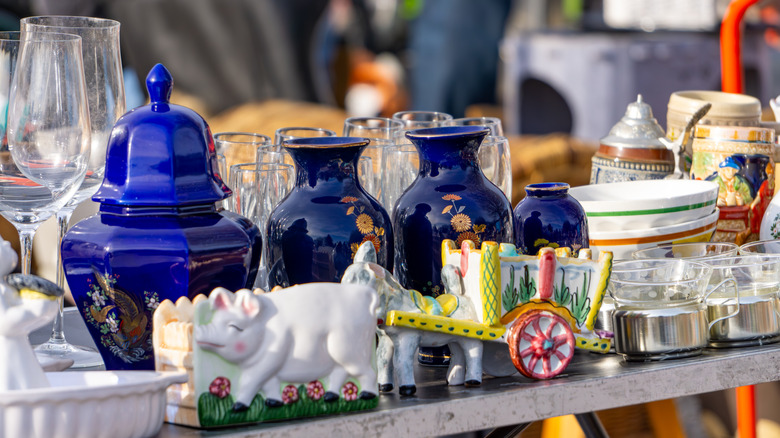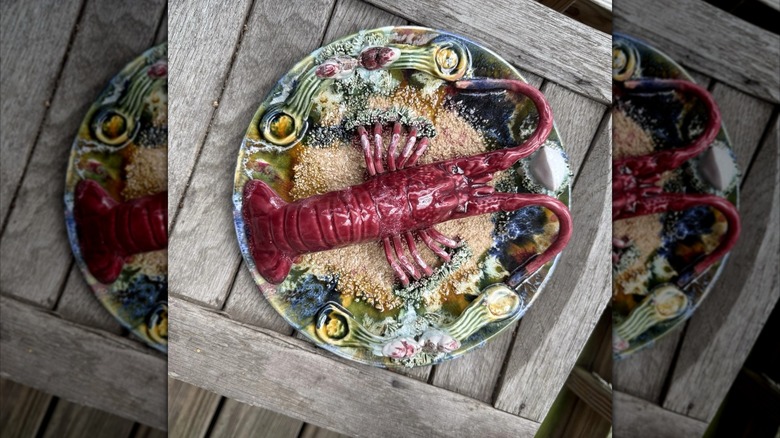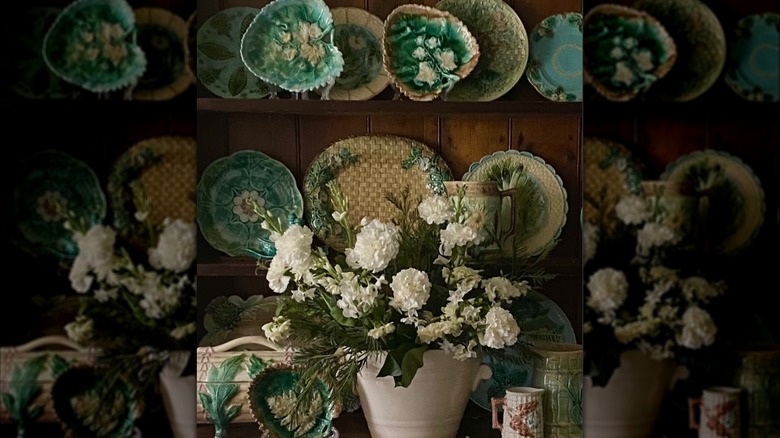The Unique Centuries-Old Kitchen Piece You Should Never Pass Up At Thrift Stores
We may receive a commission on purchases made from links.
Whether you are looking for kitchen essentials at your local thrift or interesting pieces, your local secondhand stop is the perfect place to score awesome antique finds at affordable prices. Just by strolling the aisles, you can easily find a goldmine of gems that can rack up the big bucks. And there is one unique, centuries-old kitchen piece you should never pass up at thrift stores — majolica pottery.
This type of kitchenware is tin-glazed pottery that usually portrays some kind of purposeful overarching and exaggerated design or story, including natural and Victorian history, exotic creatures, and agrarian imagery. Most of these majolica products are tableware like platters, planters, tea sets, and jugs, found in its signature shades of manganese purple, cobalt blue, antimony yellow, copper green, and iron red. Believe it or not, majolica kitchenware is still produced today. However, beginning in the 15th century, this colorful pottery was brought in from Spain to Italy and continued to travel around Europe, eventually becoming a sensation in England during the Victorian era. It even made its way to the U.S. and Australia. But by the end of the 1800s, the love of this coveted dishware waned until recent spikes of interest reemerged due to people's captivation with Victorian-era and antique items. But once you find an older piece, it is crucial to know if you have the real thing as well as how to style it in your home.
How to spot an authentic majolica find
Not every majolica piece will fetch you hundreds of dollars, like the lobster platters. Therefore, when looking for valuable versions, it is important to understand the indicators of how to authenticate your latest thrifting find. These signs include looking at quality, condition, markings, glaze color, weight, and undersurface. First and foremost, always examine the quality and condition of your majolica product. Newer items won't have intricate and sharp details and paintings like older renditions. When you find an antique piece, you'll need to assess the condition to ensure there aren't large cracks or chips as well as a dull glaze.
During a further examination, you'll want to look for any brand markings and the glaze color. While not all pottery pieces will have markings, especially smaller manufacturers or significantly older pieces, most large and well-known companies marked their products. Many contemporary versions will have no marker or a British diamond logo. Glazes on an older piece will be more precise with rich hues, while modern ones may be a bit more messy. Finally, you'll need to look at the weight and undersurface. You'll know you have an antique piece if you find it to be hefty. Reproductions are significantly lighter. Look at the undersurface of your majolica to see if you find other colors like pink, blue, or green. You'll want any other hue besides white, since that's the contemporary standard on these pieces.
How to style majolica pottery in your home
While you can fetch a pretty penny for many antique majolica products, that doesn't mean you can't stylishly include them in your own décor. There are numerous ways to decorate with pottery in your home, including displaying it on a shelf, wall, or cabinet, or even turning it into centerpieces. Since majolica pottery has such eye-popping colors, it makes sense why you would want to show off these pieces in your home. An easy way to do so is to display it as kitchen or dining room décor. Items like your platters and plates may need brackets or stands to help keep them upright so people can see their full glory. You can also create a funky gallery wall with a story by pairing it with other vintage or colorful finds, or use pieces to surround a mirror.
As a vibrant, bold effect, you can seamlessly convert your antique majolica find into a table centerpiece. Keep it simple by setting out the item by itself, or you can add other decorative elements to take it to new heights. Make a themed table setting by pairing it with contemporary majolica products like plates and vases. Some people even use this eclectic décor in other parts of their homes as a funky statement piece to complement their existing interior design by hanging it on the wall and setting it on a side table.


